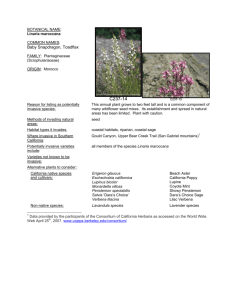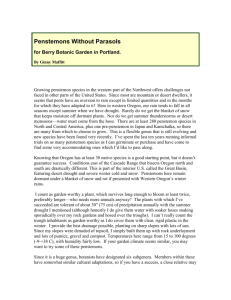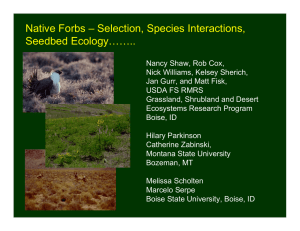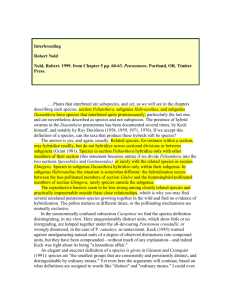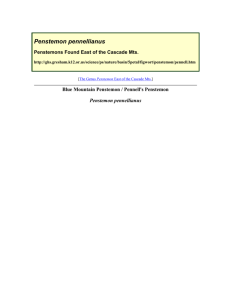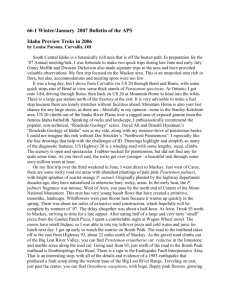P A G
advertisement
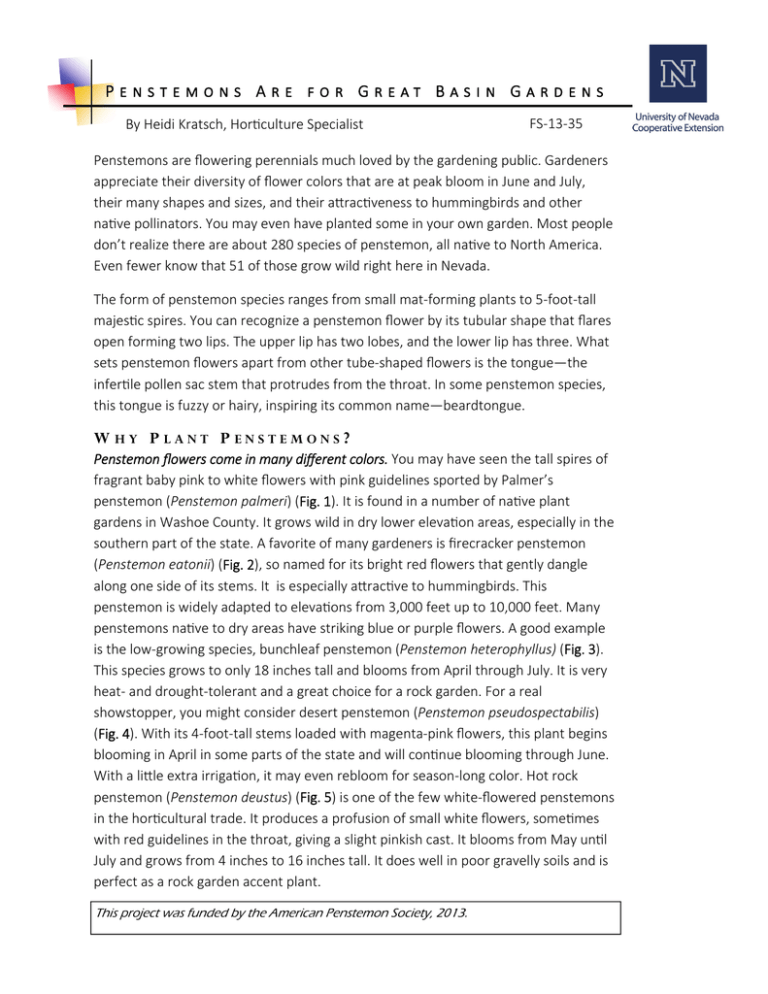
P A G B By Heidi Kratsch, Hor culture Specialist G FS‐13‐35 Penstemons are flowering perennials much loved by the gardening public. Gardeners appreciate their diversity of flower colors that are at peak bloom in June and July, their many shapes and sizes, and their a rac veness to hummingbirds and other na ve pollinators. You may even have planted some in your own garden. Most people don’t realize there are about 280 species of penstemon, all na ve to North America. Even fewer know that 51 of those grow wild right here in Nevada. The form of penstemon species ranges from small mat‐forming plants to 5‐foot‐tall majes c spires. You can recognize a penstemon flower by its tubular shape that flares open forming two lips. The upper lip has two lobes, and the lower lip has three. What sets penstemon flowers apart from other tube‐shaped flowers is the tongue—the infer le pollen sac stem that protrudes from the throat. In some penstemon species, this tongue is fuzzy or hairy, inspiring its common name—beardtongue. WHY PLANT PENSTEMONS? Penstemon flowers come in many different colors. You may have seen the tall spires of fragrant baby pink to white flowers with pink guidelines sported by Palmer’s penstemon (Penstemon palmeri) (Fig. 1). It is found in a number of na ve plant gardens in Washoe County. It grows wild in dry lower eleva on areas, especially in the southern part of the state. A favorite of many gardeners is firecracker penstemon (Penstemon eatonii) (Fig. 2), so named for its bright red flowers that gently dangle along one side of its stems. It is especially a rac ve to hummingbirds. This penstemon is widely adapted to eleva ons from 3,000 feet up to 10,000 feet. Many penstemons na ve to dry areas have striking blue or purple flowers. A good example is the low‐growing species, bunchleaf penstemon (Penstemon heterophyllus) (Fig. 3). This species grows to only 18 inches tall and blooms from April through July. It is very heat‐ and drought‐tolerant and a great choice for a rock garden. For a real showstopper, you might consider desert penstemon (Penstemon pseudospectabilis) (Fig. 4). With its 4‐foot‐tall stems loaded with magenta‐pink flowers, this plant begins blooming in April in some parts of the state and will con nue blooming through June. With a li le extra irriga on, it may even rebloom for season‐long color. Hot rock penstemon (Penstemon deustus) (Fig. 5) is one of the few white‐flowered penstemons in the hor cultural trade. It produces a profusion of small white flowers, some mes with red guidelines in the throat, giving a slight pinkish cast. It blooms from May un l July and grows from 4 inches to 16 inches tall. It does well in poor gravelly soils and is perfect as a rock garden accent plant. This project was funded by the American Penstemon Society, 2013. Fig. 1 Penstemons are na ve to a variety of habitats. The condi ons prevalent within the na ve habitat of a species give clues about its cultural requirements in a garden se ng. Some species will thrive only under a narrow range of condi ons based on their unique na ve habitats, while others are more broadly adaptable to a range of condi ons. Davidson’s penstemon (Penstemon davidsonii) (Fig. 6) is a low‐growing plant that forms a dense clump of creeping woody stems with evergreen foliage. It is found at eleva ons from 5,600 feet to 12,000 feet. Because it is adapted to areas that are snow‐covered in winter, it benefits from protec on from winter sun in areas without consistent snow cover, to prevent burning of the foliage. It prefers full sun during the growing season but tolerates part shade, especially during the early morning hours. Lovely lavender‐blue flowers that are large for its less than 10‐inch erect stems make this species a good choice for rock gardens in northern lower eleva on areas and in our high‐desert climate. Pineleaf penstemon (Penstemon pinifolius) (Fig. 7) is a shrubby evergreen found in gravelly soils on rocky slopes at eleva ons from 6,000 feet to 8,500 feet in the desert southwestern U.S. Despite its southern na ve range, it can be successfully grown in northern climates if placed among heat‐collec ng rocks in a south‐facing exposure. The leaves of pineleaf penstemon, as the name suggests, are ny and needle‐like, and the scarlet to orange‐red flowers are small and narrow but densely spaced along 15‐ inch stems. It is a good example of a species that performs best in soils that provide excellent drainage. Beardlip penstemon (Penstemon barbatus) (Fig. 8) is similarly na ve to dry mountainous habitats at eleva ons from 4,450 feet to 8,700 feet. Unlike most western U.S. penstemons that are short‐lived in the higher‐nutrient and we er soils typical of many garden se ngs, beardlip penstemon is broadly adaptable to such condi ons, as long as it gets full sun and excellent soil drainage. It blooms best in full sun but also tolerates part shade, especially in western climates where precipita on is sparse and the sun is intense. The flowers of beardlip penstemon are shaped like a shark’s head and have long‐las ng scarlet‐ colored blooms on 2‐foot‐tall to 4‐foot tall stalks. Palmer’s penstemon Fig. 2 firecracker penstemon Fig. 3 bunchleaf penstemon Fig. 4 desert penstemon Fig. 5 Rocky Mountain penstemon (Penstemon strictus) (Fig. 9) has a broad na ve range, growing at higher eleva ons between 6,700 feet and 10,750 feet in the Rocky Mountains, and in Utah, Wyoming, New Mexico and Arizona. Although many penstemon species have a shortened lifespan in soils that Some penstemons native to the western U.S. (Photo credits: John P. Weiser) hot rock penstemon hold too much water, Rocky Mountain penstemon will tolerate these condi ons but may be floppy and less brightly colored than plants grown in well‐drained soil. In contrast, Sunset Crater penstemon (Penstemon clutei) (Fig. 10) is narrowly endemic to the volcanic soils in Sunset Crater at 7,000 feet near Flagstaff, Arizona. Despite its very narrow na ve range, Sunset Crater penstemon is broadly adaptable to a variety of soil types, easy to grow and long‐lived. Like other penstemons, however, it will look its best in full sun and well‐drained infer le soil. Penstemons are easy to care for. This is especially true if you select species na ve to our region. Most penstemons love full sun and will do especially well on the south or west side of your home. They thrive in sandy, rocky soils that drain quickly. If your garden soil is clayey or shallow, you may need to create a raised bed of sand or gravel to keep the tender crown (base of the plant) out of standing water. The best soil amendment for penstemons is high‐quality aged compost applied sparingly; or be er yet use nothing at all, as most penstemons prefer infer le soils. Hybrid varie es may benefit from a light applica on in spring of a slow‐release low ‐nitrogen fer lizer to support their long bloom period. Pruning your penstemons is not necessary, but cu ng back the stems a er flowering may encourage repeat blooms and extend the life of your plants. Most penstemons grow from a basal rose e of leaves and bloom in their second year a er plan ng. Some penstemons are short‐lived, las ng only two to three years, and others may live four years or more. Penstemons will self‐sow, so be prepared for them to move around your garden. If your style of gardening is neat and dy, deadhead the flowers before they go to seed. Many penstemon species also readily hybridize with one another. When you plant more than one species in close proximity, don’t be surprised to find sports that don’t look exactly like what you originally planted. This is part of the joy of gardening with na ve plants. Growing penstemons may conserve landscape water. Most na ve penstemons are drought‐tolerant, so be careful not to overwater. Drip irriga on is best. Overwatering, especially in heavy soils, puts too much water around the base of the plant and may promote crown rot. You can protect the sensi ve crowns by using a rock or gravel mulch or by pulling organic mulch a few inches away from the stems. Hybrid penstemon varie es may require more frequent watering and will benefit from Some penstemons native to the western U.S. (Photo credits: John P. Weiser) Fig. 6 Davidson’s penstemon Fig. 7 pineleaf penstemon Fig. 8 beardlip penstemon Fig. 9 Rocky Mountain penstemon Fig. 10 Sunset Crater penstemon filtered shade. Once the bloom period is over, cut back on watering frequency for all penstemons. Penstemon gardens represent a low fire hazard. Herbaceous plants, such as penstemons, are the best choice for gardens within 30 feet of homes or other structures. They have a high moisture content and die back or are cut back during late summer and fall when fire season is at its peak. You can even plant penstemons within 5 feet of your home if you irrigate them regularly and use a noncombus ble mulch, such as rock or gravel. Penstemons a ract pollinators. Penstemon flowers are built for pollinators. Red‐flowered penstemons, such as firecracker penstemon, have deep throats and are irresis ble to hummingbirds, which enjoy sipping nectar from the base of the flower through their long beaks. Bumblebees are a racted to the larger‐flowered varie es, such as Palmer’s penstemon. Even bu erflies will visit your garden to sample the nectar of penstemons. If you plant na ve penstemons, they will a ract a variety of na ve pollinators. Encouraging na ve pollinators is good for ecosystem diversity and supports local fruit and vegetable produc on, which relies on pollina on for good harvests. Other resources: Anderson, R.M., J.D. Gunnell and J.L. Goodspeed. 2012. University Press of Colorado, Boulder, CO. Kratsch, H.A. 2011. Water‐Efficient Landscaping in the Intermountain West: A professional and do‐it‐yourself guide. Utah State University Press, Logan, UT. Ladybird Johnson Wildflower Center. Na ve Plant Database. h p://www.wildflower.org/plants. Lindgren, D. and E. Wilde (American Penstemon Society). 2012. Growing Penstemons: Species, Cul vars and Hybrids. Infinity Publishing, Haverford, PA. Mee, W., J. Barnes, R. Kjelgren., R. Su on, T. Cerny and C. Johnson. 2003. Water Wise: Na ve Plants for Intermountain Landscapes. Utah State University Press, Logan, UT. Meyer, S.E., R.K. Kjelgren, D.G. Morrison and W.A. Varga. 2009. Landscaping on the New Fron er: Waterwise design for the Intermountain West. Utah State University Press, Logan, UT. USDA Natural Resources Conserva on Service. PLANTS Database. h p://www.plants.usda.gov. The University of Nevada, Reno is an Equal Opportunity/Affirmative Action employer and does not discriminate on the basis of race, color, religion, sex, age, creed, national origin, veteran status, physical or mental disability, sexual orientation, or genetic information in any program or activity it conducts. The University of Nevada employs only United States citizens and aliens lawfully authorized to work in the United States. Copyright © 2013 University of Nevada Cooperative Extension.
